Follow Quest’s Adventures
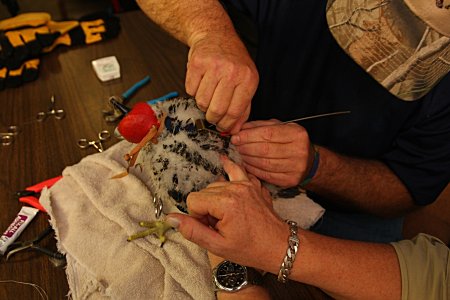
Today, with the help of the New York State Dept. of Environmental Conservation, we fitted Quest with a solar-powered satellite transmitter. Her stylish new high-tech gear will help us to track her movements after she leaves the nest box. Quest was chosen to carry the transmitter during last week’s Banding Day. Mike Allen and Barbara Loucks of the DEC found her to be the biggest of the eyases, which will give her an advantage when carrying the 22-gram transmitter.
Mark Nash of the Canadian Peregrine Foundation came from Toronto to lend his expertise, while Mike Allen got to play tailor, sewing the neoprene harness that holds the transmitter. Rochester Falconcam team members Kenn Martinez and Jim Pisello offered their assistance throughout the two hour procedure, and captured pictures as the work progressed. The team ran into a bit of trouble when they found their can of neoprene cement had solidified, but not to worry! They found an able substitute: Mexican Red ladies’ nail polish! The team used it to seal the knots in the heavy nylon thread (otherwise known as mint dental floss!) that secures the transmitter to the harness. The colorful nail polish turned out to be a good match for the harness color too! To keep Quest calm during the procedure, she got to wear a red falconer’s hood, and it worked. She went through the fitting with only a couple of squawks.
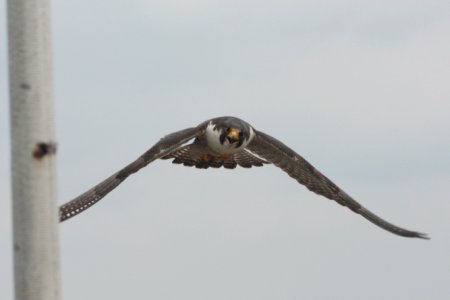
With the transmitter in place, Quest was returned to the nest box. As you can imagine, Mariah wasn’t too happy that her daughter had been eyas-napped, and she let the transmitter team hear her displeasure with lots of kacking and aggressive fly-bys. As Quest’s feathers continue to grow she’ll preen them around the harness, and it won’t interfere with her flying, hunting or eating. As soon as she starts moving around, we’ll plot her travels on a map so that everyone will be able to follow her as she “peregrinates”, or wanders on her own quest for adventure!
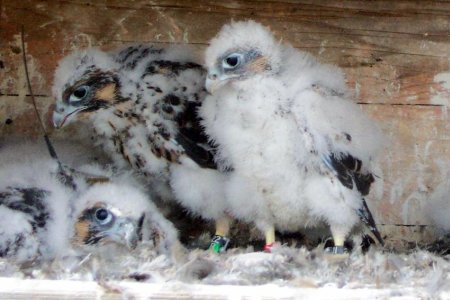
UPDATE
We’ve fitted transmitters to several of the Rochester falcons in past years. They always generate a lot of interest, a lot of questions, and some concerns, so I thought I’d take a moment to provide a little more information about them.
The modern satellite transmitter for a Peregrine weighs less than 5% of the Peregrine’s total mass. This 22 gram transmitter was fitted to the largest of this year’s females, Quest. We haven’t weighed her, but female eyases at fledging usually weigh somewhere around a kilogram or so. The transmitter and harness are about 2% of her fledging body weight. These birds will shortly be carrying food brought to them by their parents that will weigh hundreds of grams, so the weight of the transmitter is inconsequential to the fledgling’s ability to fly, hunt, or perform any of the normal functions you’d expect from a Peregrine including mating and raising a family.
Why fit a transmitter at all? Well, it turns out that even though Peregrines have made a remarkable comeback from the brink of extinction by moving into urban environments, we don’t actually know a lot about the migration patterns of these urban-raised Peregrines. Leg bands can be helpful, but they’re only useful if you can actually get close enough to read them. For a falcon on the wing that’s nearly impossible. During a migration the only way to read a band would be to capture the migrating bird every few days along its route. If you think about what it would take to actually do that in terms of time, people, and other resources, you can see that the odds are pretty small for getting any useful data that way.
The great advantage of a transmitter is that we never have to touch, see, or interact with the falcon at all in order to follow its movements. We’ll be able to get updates every few days showing the bird’s actual location, so we can plot its travels over time. This provides the potential to learn more than we ever could about migratory patterns, even from many hundreds of banded birds.
Since Mariah has been nesting in Rochester, four of her offspring have worn transmitters. Unfortunately, none survived their first year of life. At first glance, it might seem that the transmitter acted as some kind of hindrance to the birds, but that’s really not the case. Studies of captive birds wearing transmitters have shown no difference in their behavior, flight or hunting capabilities once they have adjusted to the transmitter. In Quest’s case, she’s ahead of the game because she’ll be wearing it beginning with her first flight.
The simple fact, as we have pointed out many times here at Imprints, is that the first year of life is hard for Peregrines, and many just don’t survive. In this year’s group, it is likely that three or more will not survive their first year. Of Mariah’s 38 fledglings from 1998 to 2007, we know the whereabouts of only 5. We know of the deaths of 7. So taken together, we know the status of less than 1/3 of her fledged offspring. It is likely that many more failed to survive than the seven we know of. So 4 out of 43 eyases have had transmitters. That’s fewer than 10% of Mariah’s offspring. Since the first year survival rate is something less than 50%, it is not surprising that all of the falcons fitted with transmitters have died. The two whose circumstances we know about– Hafoc and Skye– both had causes of death that had nothing to do with their transmitters. Hafoc was hit by a car, and Skye was the victim of a predator. 2001’s Mary Ann got a transmitter after she was rescued from the street and spent several weeks recovering. Her transmitter stopped working near Braddock Bay during the fall of that year. Given the time and her position, it is likely that she too fell victim to a predator, most likely a Great Horned Owl, many of which are found in the woodlands around the bay.
Finally, I’d like to repeat that the first priority of the New York State Department of Environmental Conservation, Genesee Valley Audubon Society, and the Rochester Falconcam, is the safety and well-being of Mariah, Kaver and all their offspring. We have invested much of our lives, time and effort to maximize the chances for their prosperity. We won’t do anything to jeopardize these marvelous creatures or their success.
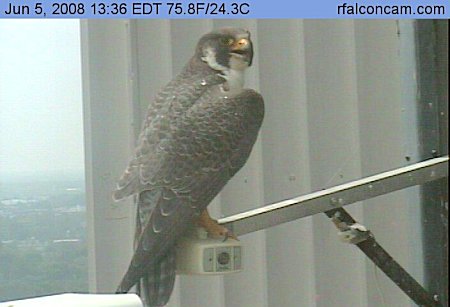
-Jess
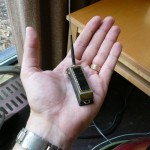
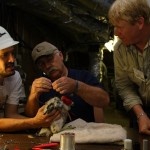
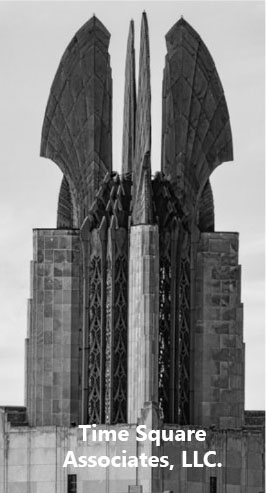
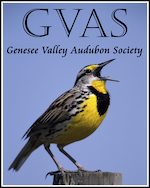
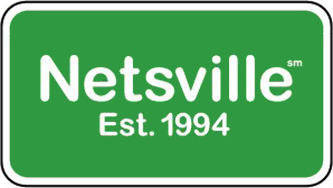
June 10th, 2008 at 10:38 AM
The film on the eyes of the birds is their eyelid. When the picture changes again, it will probably be gone.
To “t” who wishes the researchers were outfitted with transmitters : they probably are. Every cell phone that is turned on is a transmitter that tells the world where you are at any moment.
As for the transmitters handicapping the birds – there is a very famous stork in Germany, Princesschen, who has migrated to Africa year after year and brooded successfully for well over a decade wearing a series of transmitters. They first put a transmitter on her in 1994 and they followed her movements, her nesting, battles over prime nests and good mates until she was found dead in 2007 in her winter home of South Africa. During the time she had a transmitter she raised 22 young. (She also raised young when she was not wearing one and her known total of offspring with 5 different partners is 31.)
June 10th, 2008 at 1:56 PM
I have been watching this morning and it looks to me that there are only four in the box…Diamante is not there…The other’s keep looking down did he fall out….He is the smallest;;;I hope all is well… I’m worried
June 10th, 2008 at 2:24 PM
Yea…Where is Diamante? Another worried onlooker!!!
June 10th, 2008 at 2:46 PM
Caye, Diamonte is fine he was there for his share of breakfast this morning. He is smaller and has been hiding in the back behind his siblings. All is well with all 5 little ones. 🙂
June 10th, 2008 at 3:51 PM
I enjoy watching the falcons, this is the second year for me. I hope Quest makes it to adulthood, it will be nice to see her progress and travels. They are growing so fast! Thanks for all the work you all are doing.
June 10th, 2008 at 4:34 PM
@11:32 cam shows all the little fuzz balls are accounted for.
June 11th, 2008 at 12:26 AM
will we be able to see him from the site
June 11th, 2008 at 7:57 AM
bilal, if you mean will we be able to see the falcon with the transmitter from the rfalconcam website, the answer is: not after they fledge. The transmitter sends data like a GPS, it is not a camera. If you mean, will we be able to see a list of the places the young falcon visits on the rfalconcam website, well, I sure hope so!
June 11th, 2008 at 5:06 PM
@bilal- We’re working on changes to the Rochester Falconcam website that will allow our viewers to follow Quest as she roams about. Keep watching for more information.
@Donna Luker- Sorry! I’ve read your name many times but never picked up on the correct spelling 😉
@ENB- Falcons will take a drink of water every now and then, but in general they get all of the moisture they need from the prey on which they feed.
To answer your other question, there is some research that suggests at least some species of birds have a kind of built-in compass that allows them to determine direction. I’m not sure if Peregrines share this ability or if they just follow their prey during migrations. In any event, the presence of a transmitter doesn’t appear to change their migratory habits or capabilities.
@Dave H- I’m not sure whether the radio frequency will be made available or not. In 2004 we had an amateur radio hobbyist on the Fledge Watch and he was able to pick up the signal from Hafoc’s transmitter. If the DEC decides to release the frequency information then we’ll post it on Imprints!
@Terri- The family tree is a long-term work in progress. Our ultimate goal is to publish additional pages for the eyases that will be accessible from the family tree. These pages will include each falcon’s history and current status or whereabouts when it is known. We’ve been working on it for quite a few months. Some higher priority item always seems to take up our time, but we’re hopeful that we can have it completed soon.
June 11th, 2008 at 9:09 PM
Like caye, I also saw what looks like either raw skin or blood on the chest of one of the eyases. have seen it for quite some time. Does anyone know if it’s a bald spot or something else? Of course right now I can only tell that it’s not not Zephyr (yellow), or Diamante (red) and now the others have turned their backs and I can’t see their tags 🙁 !
June 12th, 2008 at 12:38 AM
I come in for a peek many times every day, and still cannot believe how rapidly the eyases are changing, even in the course of one day. I just compared today with Quest on the day of her fitting. Wow!
Thank you SO much for allowing me, and the world, to watch this always amazing event!
June 14th, 2008 at 1:30 AM
My son was working on the O’Rourke bridge this spring. He said he saw two birds nesting, with eggs, that looked like Mariah and Kaver. He’s no birdwatcher and cant tell a falcon from a turkey vulture but, it makes me wonder…
August 5th, 2008 at 3:57 PM
Any idea when Quest goes live on satellite?
May 7th, 2011 at 12:09 PM
Hi,
I believe I’ve found a dead peregrine falcon. I left a message with DEC Avon office, but I have heard no callback. The tagged bird is in Penfield near the middle school. I have the tag number on my cellphone messaging.
Hope to hear from someone,
Tony